Introduction
On this page
- Foreword – Minister for Seniors
- Why do we need a new strategy
- How this strategy fits with other related strategies
- Approach and focus
- The case for change
Foreword – Minister for Seniors
E ngā mātāwaka o te motu, tēnā koutou katoa. Kei aku rangatira, koutou aku kaumātua kia whakapuaki nei au i ēnei mihi itiiti āku i tō koutou manawanui ki te tuku i ō tātai whakapapa, ō whare kōrero ki ngā whakatipuranga e kitea ai he rangatira mō rātou. Nā koutou i iri ai ngā kohinga kōrero ki ngā pakitara o ngā whare tīpuna. E hua ake nei tōna whakatinanatanga ko tātou kua whāiti mai ki te whakaaro kotahi ki te mahitahi atu i konei.
To the tribal groups of our nation, greetings to you all. To our respected leaders and elders, with these few words I acknowledge you all, especially for the manner in which you act as an example to the younger generations. It is your guidance and wisdom that ensures the survival and retention of our knowledge and traditions. This recognition is reflected here in our working together to develop a strategy for the benefit of all.
I am pleased to launch Better Later Life – He Oranga Kaumātua 2019 to 2034.
This strategy takes a fresh look at what we have to do to make sure New Zealand has the right policies in place for our ageing population. We need to think about the issues we face as a country. Importantly, we need to think from the perspective of every single New Zealander and what they want as they age. This strategy is designed to test our thinking and focus on the priorities for action to help ensure New Zealand is a great place to age.
By 2034 we expect that there will be around 1.2 million people aged 65 and over, just over a fifth of our total population, and nearly 180,000 people aged 85 and over. This will represent a significant change for New Zealand and is cause for celebration. People are not only living much longer, they also tend to be healthier for longer. This gift of longevity means that we need to rethink the existing notions of old age and retirement.
In 2018 I held a national conversation to ask what people thought a new strategy for our ageing population should cover. I appreciate the many people and groups that contributed submissions and I really enjoyed the workshops I attended.
The areas of focus in the strategy reflect what many people said were important for a better later life – having an adequate income and a place to live, feeling socially connected, being able to get around in their community and having access to affordable health care. Some older New Zealanders will need support to achieve these things.
People also said it’s important that society continues to value older people and to stop using stereotypes when thinking about and interacting with them.
All too often the conversation on our ageing population focuses on what it will cost. I want this strategy to be different, looking more broadly at how people can have better later lives and also recognising the significant contribution older people have made and continue to make to New Zealand.
Good progress has been made in preparing for an ageing population, but there is more work to do. We need to take a long-term view, working together and prioritising our efforts to ensure New Zealand is a great place to age.
Central government can provide leadership, but local government, nongovernmental organisations, families and whānau and individuals all have an important role to play in making the future better for New Zealanders as we age.
Hon Tracey Martin
Why do we need a new strategy
Te take me whai rautaki hou
We (meaning all New Zealanders) need to make sure New Zealand embraces the opportunities that an ageing population and longevity brings.
This strategy will help ensure we create opportunities for everybody to participate, contribute and be valued as we age. Many older people are living well, but the number who are not is likely to increase in the future.
Much was achieved through the previous strategy. The Positive Ageing Strategy 2001 used a wide range of indicators that were intended to identify key issues and where action was needed. In 2001 the changing demographic profile was still in the future, whereas in 2019 it is upon us. What we need now are actions supported by targeted indicators that measure progress and drive performance.
The number of people aged 65+ is increasing, and this trend will continue. The ways we live are changing. Our population is more diverse, with many different ethnicities and family structures. Technological developments will continue to affect our lives and provide opportunities as we age.
Our ageing population also reflects increased longevity, which is an achievement offering opportunities for all people irrespective of their age. Many of us will continue working as we age, supporting families and whānau, passing on knowledge, volunteering and contributing to society. However, growing numbers of older people are not doing so well. Things like lifelong disability, health issues, job losses and relationship breakdown can impact how we live our later life. These factors may result in complex needs, poorer outcomes and challenges accessing services.
We need to pay particular attention to the interests of Māori and be guided by Te Tiriti o Waitangi as a founding document of our country. We will work with iwi, hapū and whānau to ensure that these commitments guide the development and implementation of the strategy, and that the needs and aspirations of kaumātua are reflected in it.
How this strategy fits with other related strategies
Te hononga o tēnei rautaki ki ērā atu rautaki whai pānga
This strategy has links to, and complements, a number of other strategies, including:
Healthy Ageing Strategy 2016
Health is a key aspect of ageing and wellbeing. The Healthy Ageing Strategy takes a life-course approach seeking to maximise health and wellbeing for all older people so that older people live well, age well, and have a respectful end of life in age-friendly communities,
New Zealand Disability Strategy 2016
As age increases so does the likelihood of living with a long-term health condition, or a disability requiring ongoing support. The New Zealand Disability Strategy vision is: New Zealand is a non-disabling society a place where disabled people have an equal opportunity to achieve their goals and aspirations, and all of New Zealand works together to make this happen.
New Zealand Carers Strategy 2008 and New Zealand Carers Strategy Action Plan
Older people are often on both sides of the caring relationship at different times. They may be caring for partners, parents, friends or mokopuna, but may require care themselves later in life. The Carers Strategy Action Plan is likely to result in resources and meaningful, practical support to help people in a caring role
There are many other strategies that include or impact older people for example, the National Strategy for Financial Capability 2015- 2025, the Employment Strategy, the Careers and Road Safety strategies (both under development) and the Government Policy Statement on Land Transport. There are other work programmes with implications for older people too; these include digital inclusion, family violence and sexual violence, housing, and three-yearly review of retirement income policies. As other strategies and work programmes are developed, they will need to consider and address the interests and issues of older people and be guided by this strategy.
The Treasury Living Standards Framework informed the development of this strategy and the initial indicators. New Zealands commitment to the United Nations Sustainable Development Goals has also been considered in the development of this strategy. In combination with the Healthy Ageing Strategy, this strategy will also address the World Health Organization 10 Priorities for a Decade of Action on Healthy Ageing, 2020-2030.
Approach and focus
Te huarahi me te aronga
Focus on 65+, but we consider the next generation of older people too
The Positive Ageing Strategy 2001 focused on those aged 65+, as does this one. However, this strategy also considers the next generation of older people currently aged 50 to 64. This recognises that those in their 50s will be 65+ within the timeframe of this strategy
Terms used in this strategy
In this strategy the term:
- Older people means people aged 65+ but recognises the diversity of this age group- people age differently and have different aspirations and needs.
- Later life means the years after reaching the age of eligibility for New Zealand Superannuation (NZ Super), because New Zealand does not have a retirement age.
- Older workers means people aged 50+ working or seeking work
Funding and resourcing
Achievement of this strategy depends on the resourcing and funding allocated to it. Some initial actions are being funded out of baselines, or already have funding allocated to them. This strategy is a roadmap that provides the direction for older New Zealanders to lead valued, connected and fulfilling lives. It relies on central government (including individual agencies), local government, community organisations and communities prioritising actions and allocating resources to address the key areas for action within it.
The case for change
Te take me whakahou
The current situation
Many older New Zealanders enjoy a good life and will continue to do so. Older people contribute to society, communities, the economy, and families and whānau through work both paid and unpaid, volunteering, and as carers for partners and other family and friends, as well as through tax contributions and consumer spending.
Older people also contribute value through their knowledge, experience and commitment, and in many cases, they are treasured.
New Zealand’s labour force will be increasingly reliant on older workers, and older workers are already helping to address skills and labour shortages in some regions and sectors. However, many employers have yet to recognise this and are not yet well placed to adapt to an ageing workforce.
Many older workers are valued by employers, but challenges remain, including negative attitudes towards older workers (ageism). Older workers can miss out on retraining or upskilling despite the fact that they tend to stay with an employer for considerably longer than younger people.
Some of our communities are well set up and adapting to our ageing population. Others do not have enough facilities, accessible places, and services for older people. Public transport is important for mobility and accessibility, and not everyone has good access to other options such as walking or driving.
Older people can face a range of housing issues, including affordability, accessibility, quality, location, insecurity of tenure, homelessness, and challenges in releasing equity from housing. These issues can have a significant impact on wellbeing as we age.
All these current challenges and opportunities are expected to continue and increase as numbers of older people increase.
What is changing?
New Zealand’s population is ageing.
- In New Zealand, the number of people aged 65+ is increasing, while the birth rate has been decreasing since the mid-1970s.
- Sometime in the next decade there will be more people aged 65+ than children aged14 years.
- The proportion of older people compared to the rest of the population is increasing. By 2034, there will be 1.2 million people aged 65+ (21 percent - just over a fifth of the population).
The make-up of the 65+ population is also changing, with more people living longer.
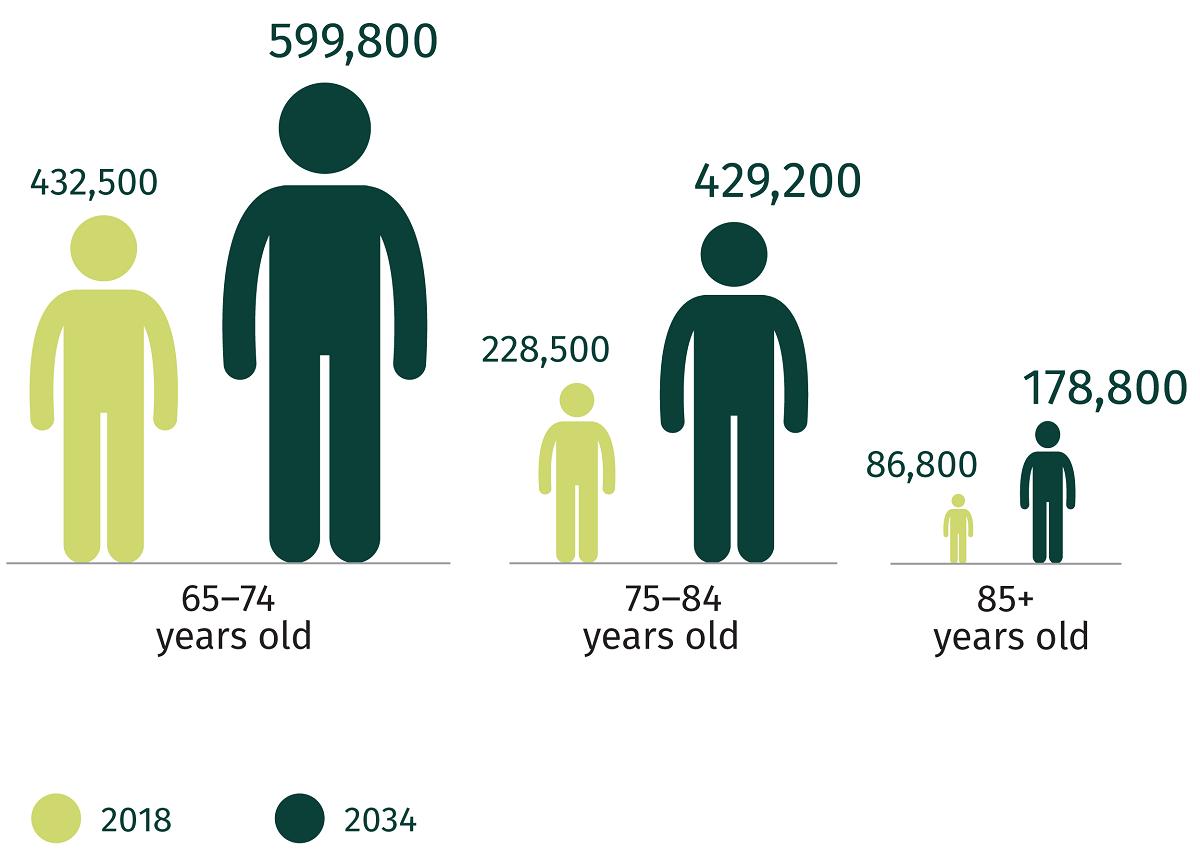
We are living longer than at any previous time in history, with life expectancy continuing to increase
Our population is more diverse
Numbers of older people are increasing across all ethnicities.
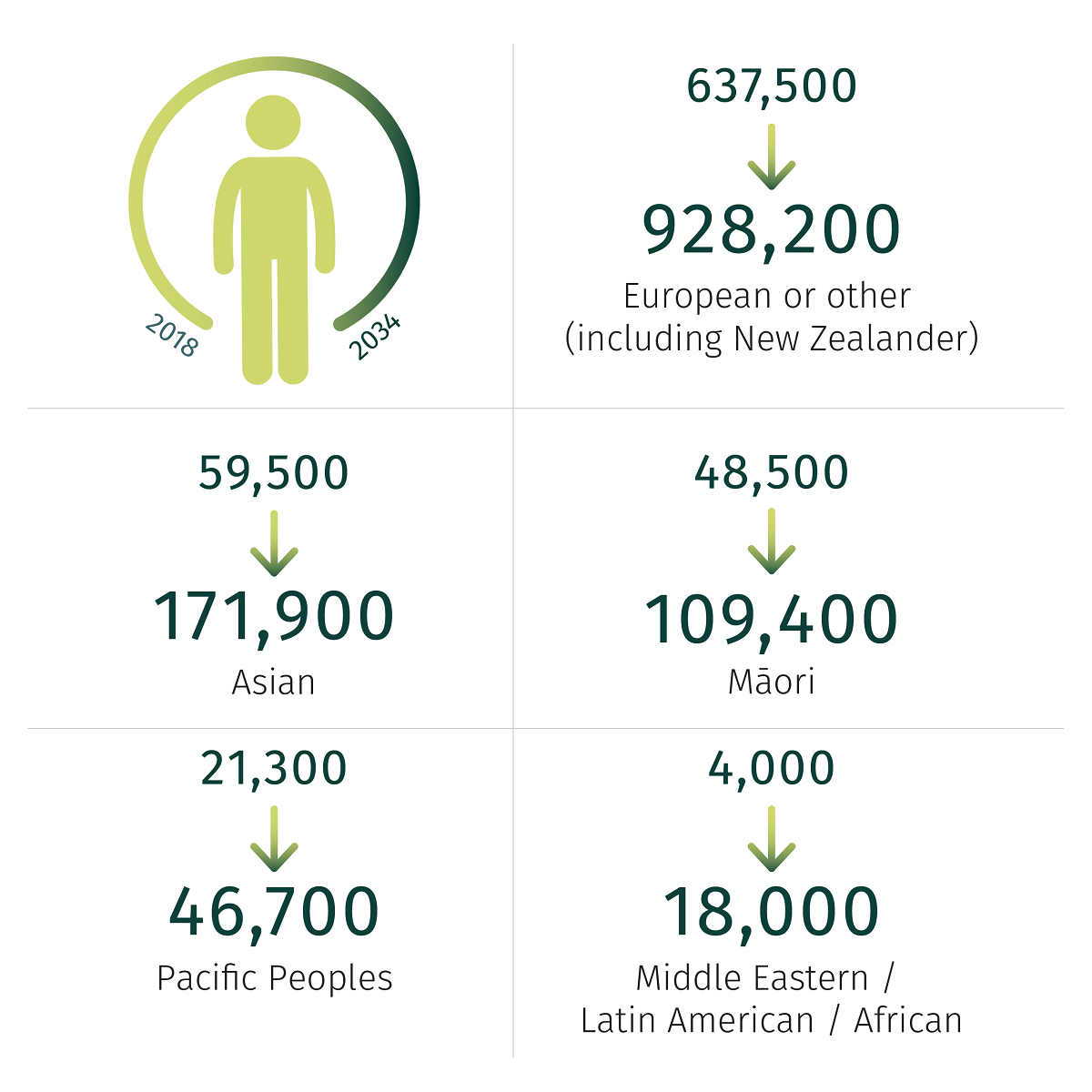
New Zealand is becoming increasingly diverse. There are more than 200 ethnic groups in New Zealand, and collectively, we speak 190 different languages.
As well as ethnicity, diversity also includes differences in age, religion, philosophy, socioeconomic background, sexual orientation, gender identity, intelligence, physical abilities, mental health, physical health, disabilities, genetic attributes, personality, and behaviour. This increased diversity means people who make up the older population may have different aspirations and needs as they age.
The ways that older people live are changing
Many older people live in intergenerational households, retirement villages or residential care, and many others live alone.
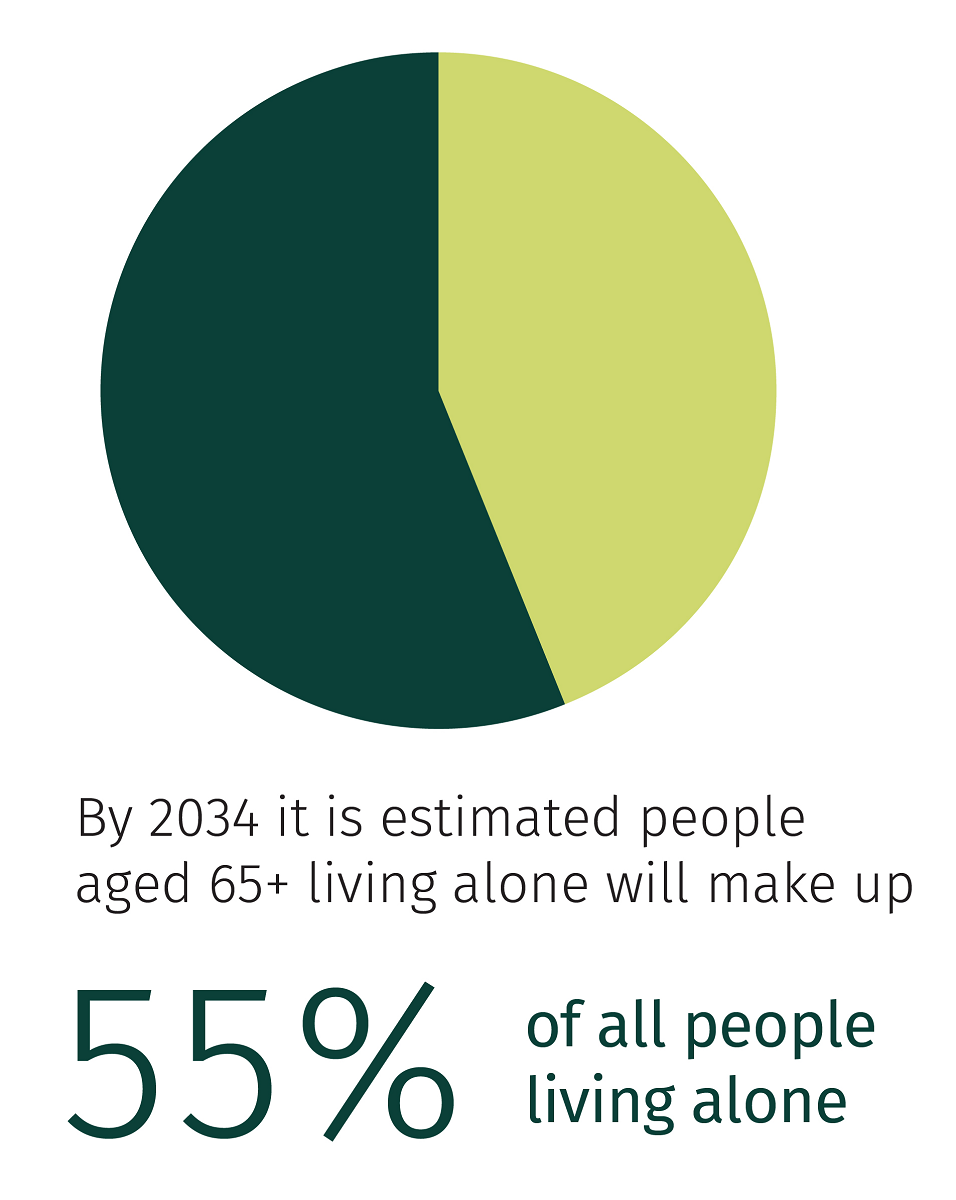
Our population is highly mobile, and people are having fewer children. This is expected to result in more older people living alone without family and whānau support. However, for some groups, intergenerational households are expected to increase.
Increasing longevity positively impacts families and whānau. Many older people contribute to our families and whānau – they are treasured, and pass on knowledge, skills and traditions. They provide help such as looking after grandchildren/mokopuna. Kaumātua Māori often have cultural responsibilities maintaining cultural rituals and traditions and attending to the needs of whānau, hapū and iwi.
Some older people will have increased caring responsibilities for both older and younger generations. Others will not have family or whānau who can support them or provide day-to-day care.
An ageing workforce and more older workers
Nearly one in four people aged 65+ are in paid employment.
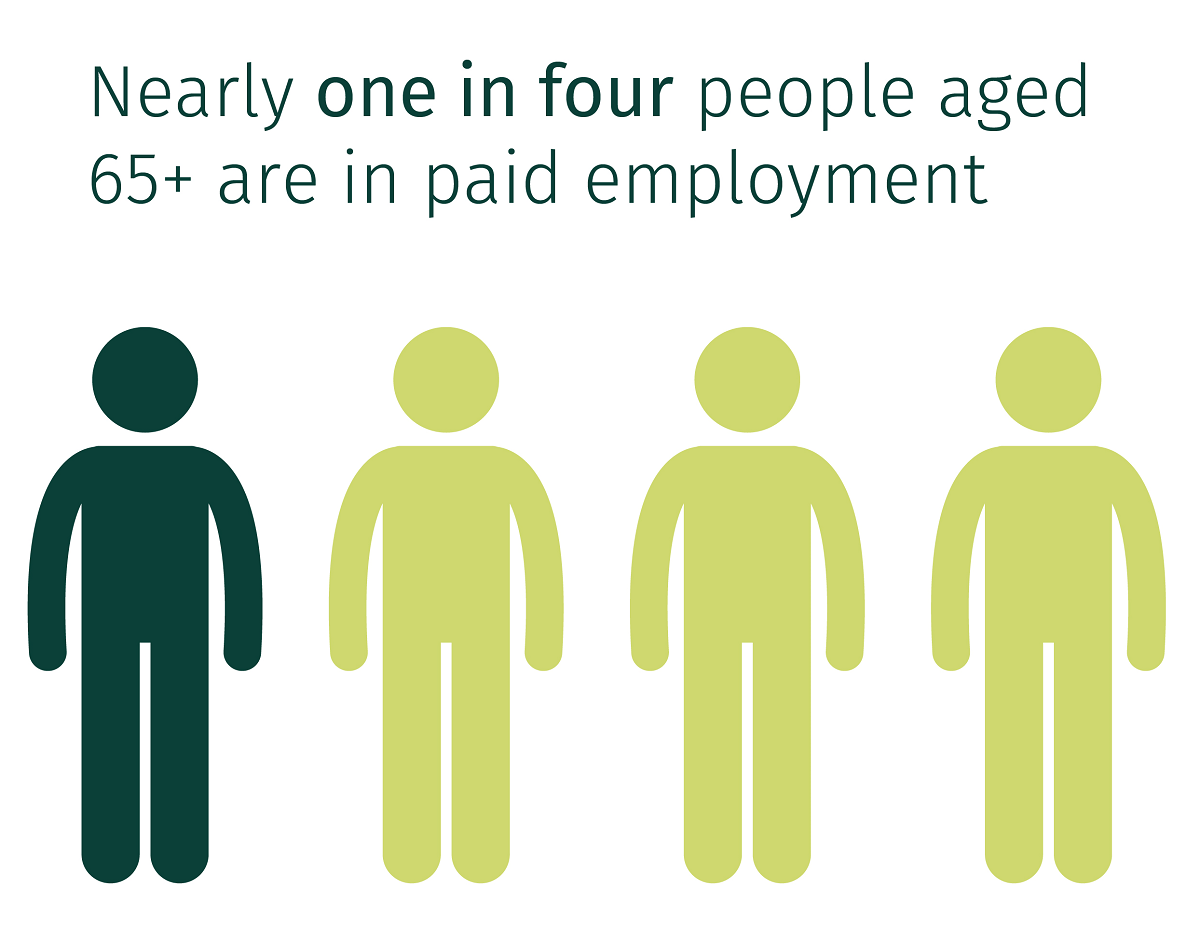
The New Zealand workforce is ageing. Many occupations already have significant proportions of older workers, including in the education and health sectors. There is increased demand for workers in other sectors too, including the aged care sector. Many workplaces will need older workers to maintain or grow their businesses.
People may want to work for financial or social reasons, for a sense of purpose, or because they do not feel ready to retire. Working past 65 is already becoming the norm.
Greater contribution by older people
Older people make a significant contribution to society. It is projected that by 2036, those aged 65+ will contribute (in 2016 dollars):
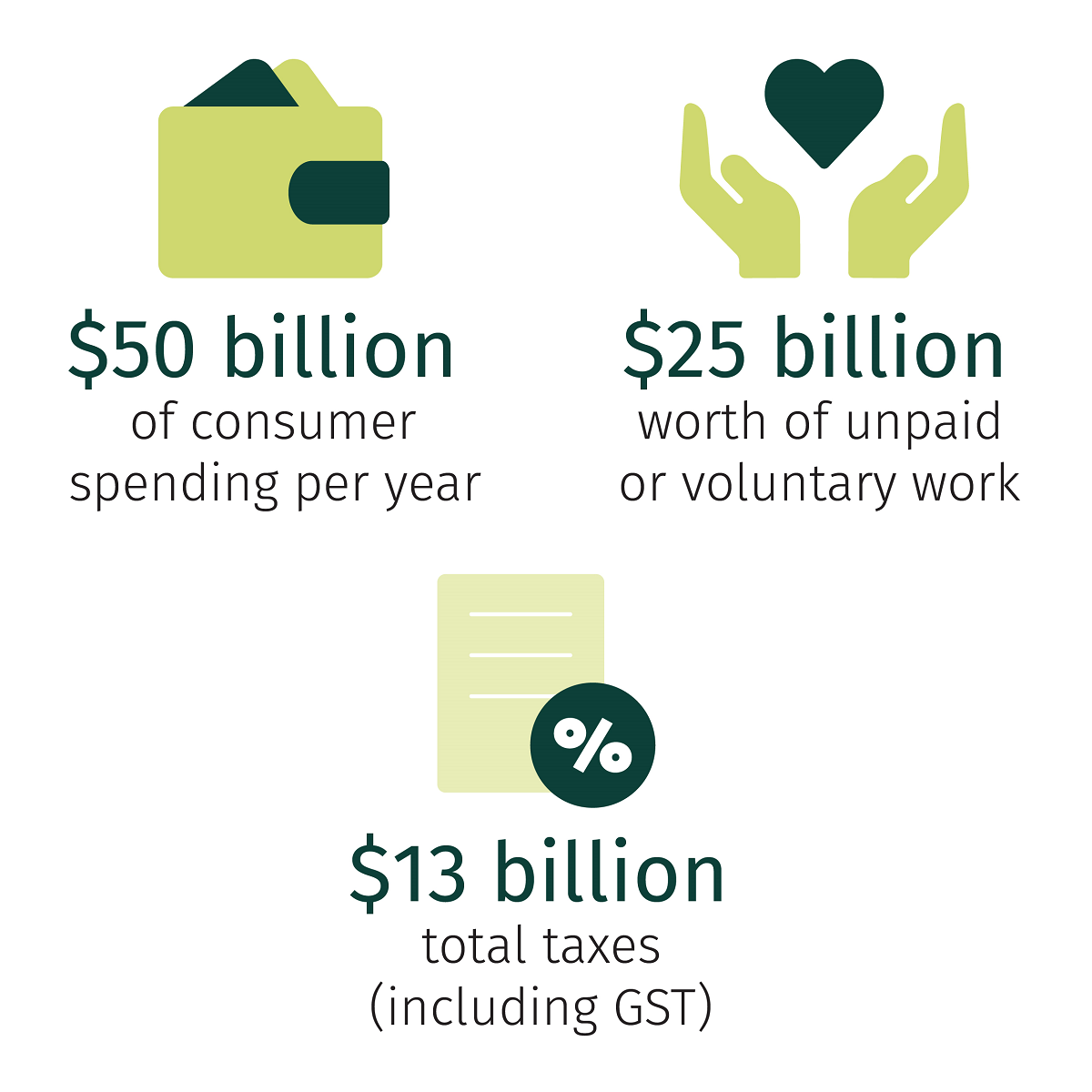
Older people are also likely to lead new businesses, invest and drive technological developments, and innovate in other ways for everyone’s benefit.
People’s ability to save for, and fund their later years
Women tend to have lower levels of wealth (assets minus debt), reflecting gender pay gaps and lower levels of workforce participation during their lives.
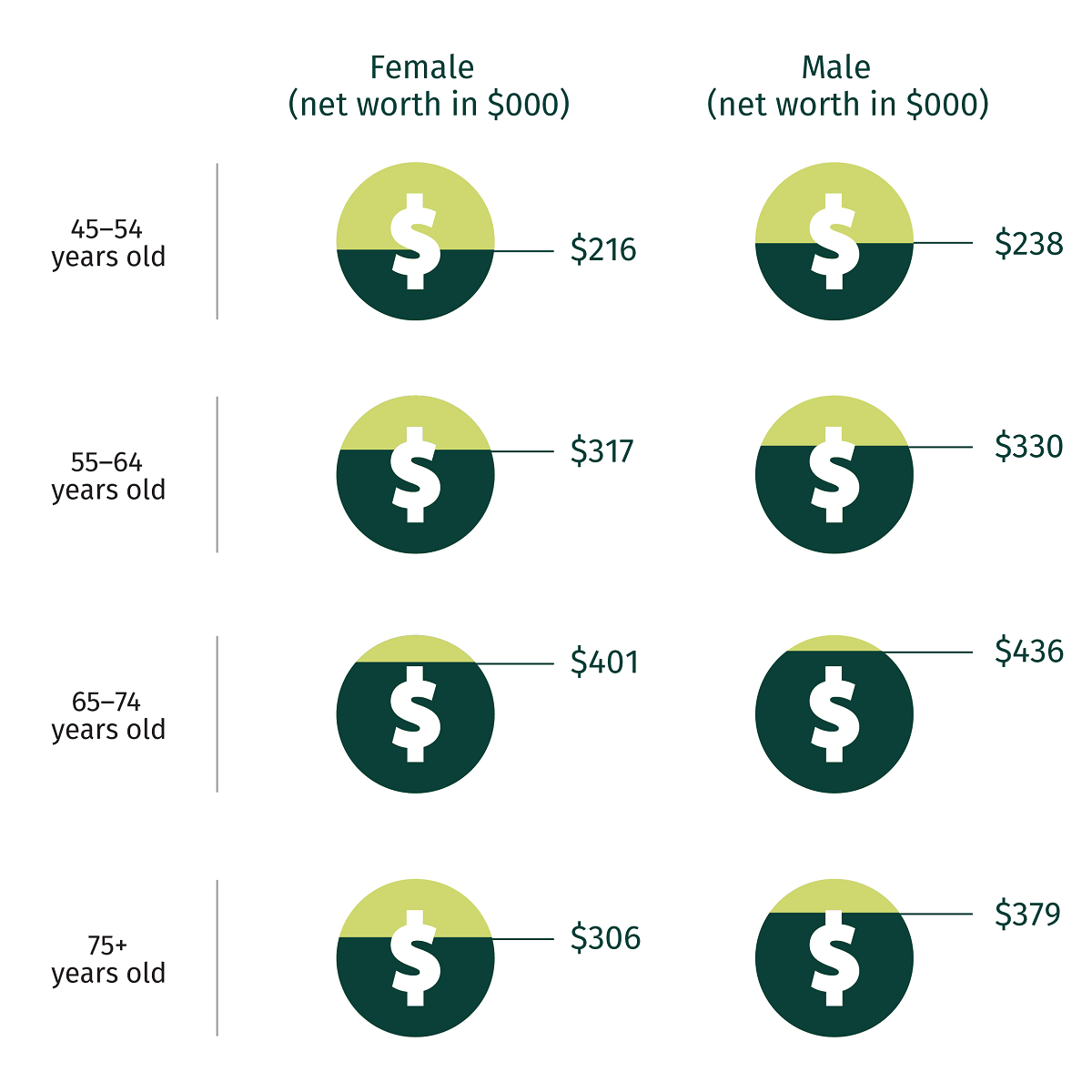
Housing
Older people are currently more likely than any other age group to own their own home, but this is dropping for those aged 50–64.
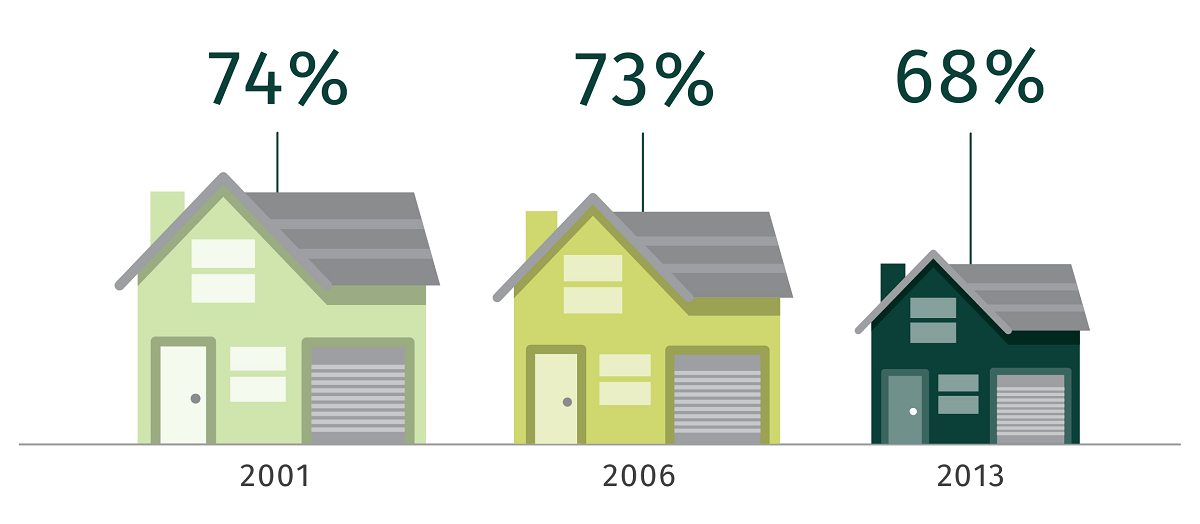
For older people who do own their home, the numbers with mortgages are increasing.
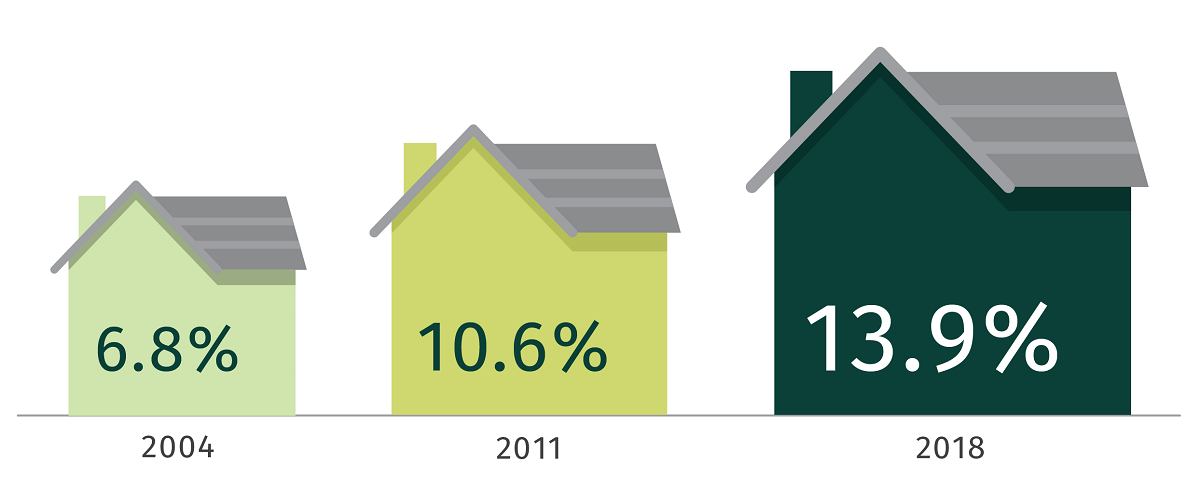
This can be challenging if NZ Super is the sole source of income. Home ownership costs such as rates and insurance are also increasing and can be a major cost. There will be more older people renting in the future too.
Some may need more support
Based on current trends such as reducing home ownership, increasing financial hardship amongst those aged 50-64, and the projected increase in the number of people aged 65+, there is a risk of more older people experiencing poverty and needing some assistance alongside NZ Super.
Savings schemes such as KiwiSaver will most likely mean that more New Zealanders will be better prepared financially for later life. However, for varying reasons, some people may have little or no savings or may be in debt.
Technology is changing our lives too
Technology presents an opportunity to improve our lives as we age. In the next 15 years, there will continue to be significant technological developments that will improve health care, facilitate lifelong learning, and help us to stay connected with family and friends.
However, these developments may also be a barrier for some older people who are digitally excluded, have limited skills, are unable to afford the Internet or other digital technology or may find it difficult to upgrade the technology they have. Some people are concerned that digital services may reduce face-to-face interaction, which they value. On the other hand, many are using social media to stay in touch with family and whānau around the world.
Our world is increasingly moving online, and the proportion of older people comfortable with digital technology is also increasing.
Attitudes to older people
While there are generally high levels of respect for older people, some continue to view older people as a burden. This needs to change. It is important that older people are connected to their communities and can contribute.
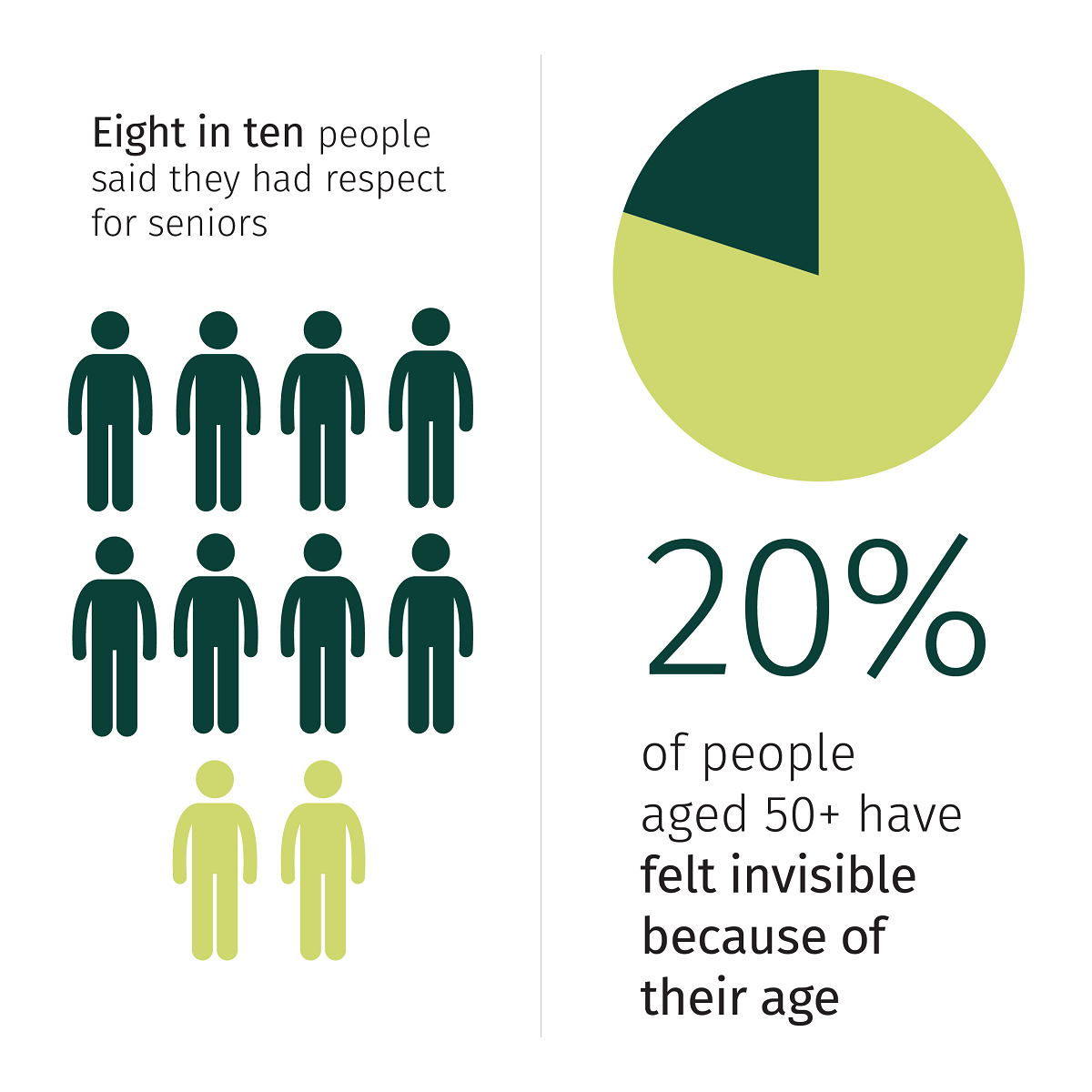
More partnerships and community-driven change
Communities have always taken a strong lead in pursuing local opportunities and addressing challenges to ensure they are good places to live in. The World Health Organization’s Global Network for Age-friendly Cities and Communities will become increasingly important. New Zealand is an affiliate member of this network, with some communities actively working towards being age-friendly.
We are also seeing increased use of different models such as social enterprise and crowd funding to achieve community aspirations.
Impacts on central and local government spending
There will be greater government spending on older people through NZ Super and health care as numbers receiving NZ Super increases and more people access health services. This will present a challenge for New Zealand, including how best to adapt to a growing older population.
Although people are remaining healthy for longer, growing numbers mean that more people will have health-related issues and disabilities. Advancements in health care will help, but they could also result in increased demand for new services.
A changing population profile is likely to have a greater impact in some regions, particularly in small towns and rural areas. By 2038, only three territorial authority areas are projected to have less than 20 percent of their population aged 65+. Demand will increase for locally provided services and infrastructure. At the same time, more people will be solely reliant on NZ Super, meaning councils could face increasing rates arrears and/or pressure not to increase rates – limiting their ability to meet community needs and aspirations.
Broader economic impacts
Population ageing will have a range of effects on the broader economy.
As the population ages, more older people will be drawing on their savings and investments, while younger people may be saving more for their later years. The national mix of investments could change if more older people prefer lower-risk term investments rather than investments yielding the greatest benefit to economic growth. Economic growth could also be limited by skill and labour force shortages as our population ages, but this may be mitigated by a more skilled workforce and increased contributions by older workers.
Climate change and natural hazards
The impacts of climate change and natural disasters such as earthquakes may affect older people in a number of ways. Some older people living in coastal communities could be at risk from rising sea levels and coastal erosion, as well as increased flooding in some areas.
Insurance is becoming unaffordable or unavailable in certain areas, impacting on older people’s financial security and living choices.
Global context
New Zealand’s population is slightly younger than the OECD average. While our older population is growing, other countries have aged faster, such as Japan, where more than 25 percent of their population is aged 65+. New Zealand can learn from their experience adapting to demographic changes.